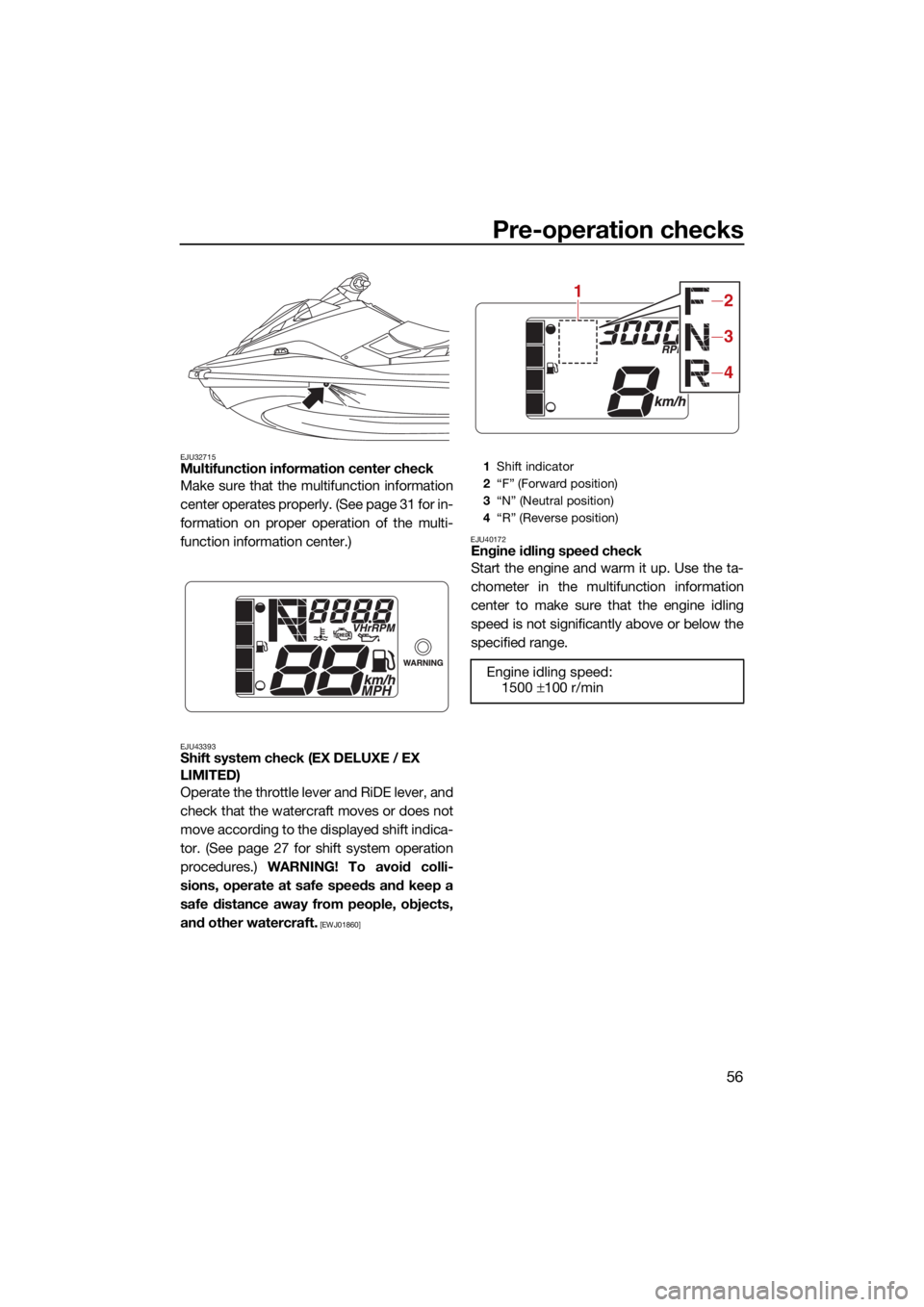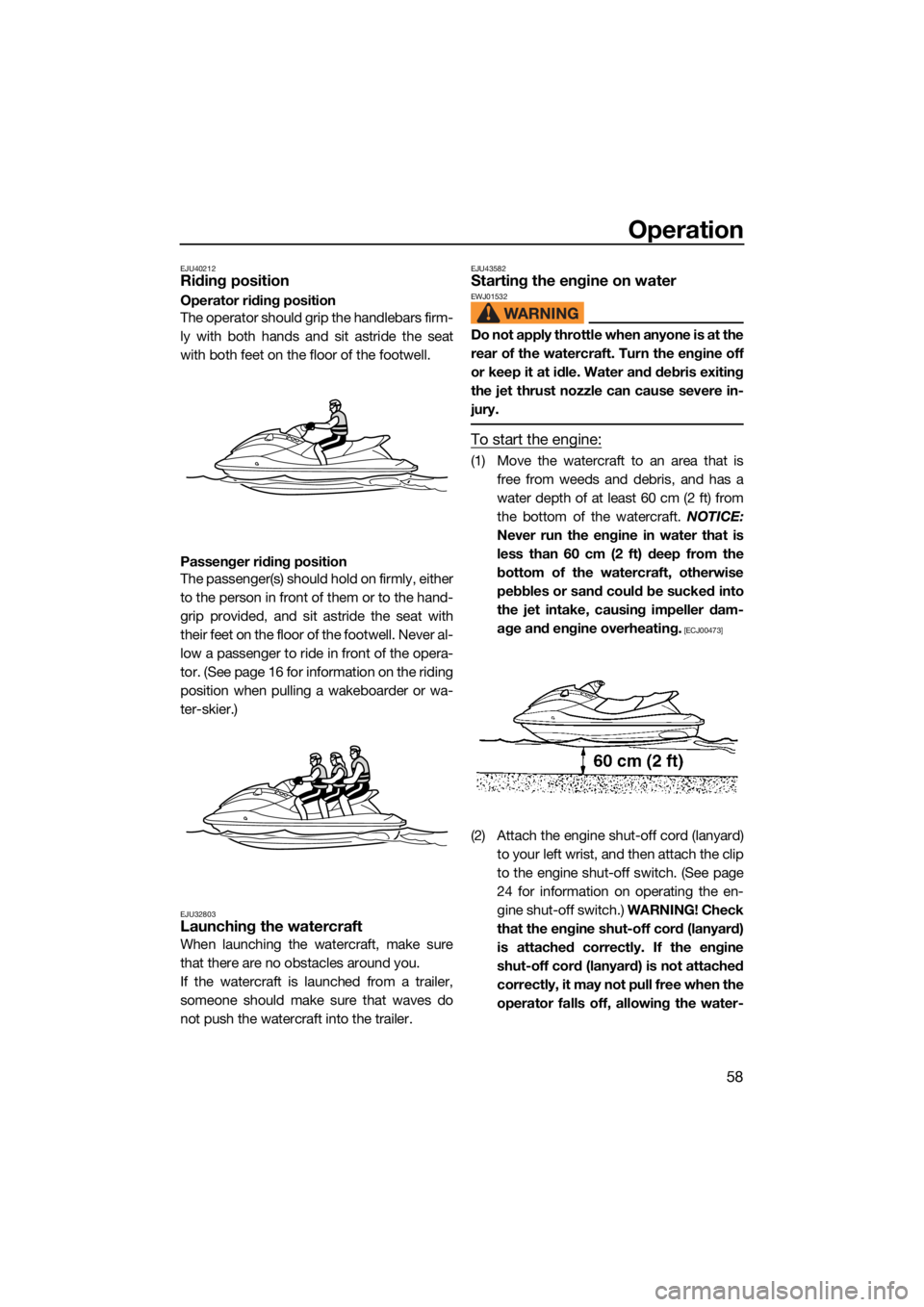check engine YAMAHA EX 2022 Owner's Manual
[x] Cancel search | Manufacturer: YAMAHA, Model Year: 2022, Model line: EX, Model: YAMAHA EX 2022Pages: 100, PDF Size: 4.74 MB
Page 62 of 100

Pre-operation checks
55
EJU44252Stern drain plug checks
Loosen the stern drain plugs and remove
them, and then make sure that the plugs and
O-rings on the plugs are not damaged and
that there is no foreign material on the
threads or O-rings on the plugs. NOTICE:
Before installing the stern drain plugs,
clean the drain plug threads and the O-
rings on the plugs to remove any foreign
materials, such as dirt or sand. Otherwise,
the stern drain plugs could be damaged,
allowing water to enter the engine com-
partment. Check the O-rings on the stern
drain plugs and make sure that the plugs
are tightened securely before launching
the watercraft. Otherwise, water may
flood the engine compartment and cause
the watercraft to submerge.
[ECJ00364]
Securely install the stern drain plugs by tight-
ening them until they stop.
EJU44640Hood check
Close the hood, hook the hood latches, and
check that the hood is securely closed.
EJU40147Post-launch checks
Perform the post-launch checks in the pre-
operation checklist while the watercraft is in
the water and the engine is running.
To perform the post-launch checks:
(1) Launch the watercraft. (See page 58 for information on launching the watercraft.)
(2) Perform the checks and make sure that there are no malfunctioning items or oth-
er problems.
EJU40553Cooling water pilot outlet check
Make sure that water is discharged from the
cooling water pilot outlet while the engine is
running. (See page 26 for information on the
cooling water pilot outlet.)
1Stern drain plug
2 O-ring
2
1
1Stern drain plug
1 Hood latch
1
1
UF3Y75E0.book Page 55 Tuesday, July 27, 2021 2:27 PM
Page 63 of 100

Pre-operation checks
56
EJU32715Multifunction information center check
Make sure that the multifunction information
center operates properly. (See page 31 for in-
formation on proper operation of the multi-
function information center.)
EJU43393Shift system check (EX DELUXE / EX
LIMITED)
Operate the throttle lever and RiDE lever, and
check that the watercraft moves or does not
move according to the displayed shift indica-
tor. (See page 27 for shift system operation
procedures.) WARNING! To avoid colli-
sions, operate at safe speeds and keep a
safe distance away from people, objects,
and other watercraft.
[EWJ01860] EJU40172
Engine idling speed check
Start the engine and warm it up. Use the ta-
chometer in the multifunction information
center to make sure that the engine idling
speed is not significantly above or below the
specified range.
1
Shift indicator
2 “F” (Forward position)
3 “N” (Neutral position)
4 “R” (Reverse position)
Engine idling speed:
1500 ±100 r/min
12
3
4
UF3Y75E0.book Page 56 Tuesday, July 27, 2021 2:27 PM
Page 65 of 100

Operation
58
EJU40212Riding position
Operator riding position
The operator should grip the handlebars firm-
ly with both hands and sit astride the seat
with both feet on the floor of the footwell.
Passenger riding position
The passenger(s) should hold on firmly, either
to the person in front of them or to the hand-
grip provided, and sit astride the seat with
their feet on the floor of the footwell. Never al-
low a passenger to ride in front of the opera-
tor. (See page 16 for information on the riding
position when pulling a wakeboarder or wa-
ter-skier.)
EJU32803Launching the watercraft
When launching the watercraft, make sure
that there are no obstacles around you.
If the watercraft is launched from a trailer,
someone should make sure that waves do
not push the watercraft into the trailer.
EJU43582Starting the engine on waterEWJ01532
Do not apply throttle when anyone is at the
rear of the watercraft. Turn the engine off
or keep it at idle. Water and debris exiting
the jet thrust nozzle can cause severe in-
jury.
To start the engine:
(1) Move the watercraft to an area that isfree from weeds and debris, and has a
water depth of at least 60 cm (2 ft) from
the bottom of the watercraft. NOTICE:
Never run the engine in water that is
less than 60 cm (2 ft) deep from the
bottom of the watercraft, otherwise
pebbles or sand could be sucked into
the jet intake, causing impeller dam-
age and engine overheating.
[ECJ00473]
(2) Attach the engine shut-off cord (lanyard) to your left wrist, and then attach the clip
to the engine shut-off switch. (See page
24 for information on operating the en-
gine shut-off switch.) WARNING! Check
that the engine shut-off cord (lanyard)
is attached correctly. If the engine
shut-off cord (lanyard) is not attached
correctly, it may not pull free when the
operator falls off, allowing the water-
UF3Y75E0.book Page 58 Tuesday, July 27, 2021 2:27 PM
Page 70 of 100

Operation
63
EWJ01971
Allow adequate stopping distance. Stay
far enough away from others so you can
always safely coast to a stop.
Take early action to avoid collisions. Re-
member, watercraft and other boats do
not have brakes.
Operate defensively at safe speeds and
keep a safe distance away from people,
objects, and other watercraft to give you
time to stop.
Do not shut the engine off when slowing
down in case you need engine power to
steer away from a boat or other obstacle
that comes into your path.
EX SPORT: Do not use the reverse func-
tion to slow down or stop the watercraft
as it could cause you to lose control, be
ejected, or impact the handlebars.
EX DELUXE / EX LIMITED: To avoid
rear-end collisions while operating the
watercraft, check behind you before us-
ing the RiDE lever to slow down or stop
the watercraft.
EJU44682Operating the watercraft in reverse or
neutral (EX SPORT / EX DELUXE / EX
LIMITED)
Operating in reverse (EX SPORT)
Pull the shift lever rearward to the reverse po-
sition. The watercraft will move in reverse.
(See page 27 for information on the reverse
system.) Make sure that there are no obstacles or peo-
ple behind you before shifting into reverse.
TIP
This model is not equipped with a neutral
function.
Operating in reverse (EX DELUXE / EX
LIMITED) When the RiDE lever is squeezed, the “R” (re-
verse) shift indicator will be displayed and the
watercraft will move in reverse. (See page 27
for shift system operation procedures.)
1 Shift lever
2 Reverse position
1
2
UF3Y75E0.book Page 63 Tuesday, July 27, 2021 2:27 PM
Page 79 of 100

Care and storage
72
(7) Run the engine at idling speed for about3 minutes watching the engine condition.
If the engine stops while flushing, turn
the water supply off immediately and
perform the procedure again from step 6.
NOTICE: Do not supply water to the
cooling water passages when the en-
gine is not running. The water could
flow back through the muffler into the
engine, causing severe engine dam-
age.
[ECJ00123]
(8) Turn the water supply off.
(9) Discharge the remaining water out of the cooling water passages by alternately
squeezing and releasing the throttle lever
quickly for 10 to 15 seconds.
(10) Stop the engine.
(11) Remove the garden hose adapter, and then securely install the flushing hose
connector cap by tightening it until it
stops.
(12) Securely install the seat storage com- partment and seat in their original posi-
tions.
EJU44770Cleaning the watercraft
(1) Remove the seat and fire extinguisherholder. (See page 36 for seat removal
and installation procedures and page 40
for information on the fire extinguisher
holder.) (2) If the watercraft will be stored for a week
or more, rustproof the internal engine
components to help prevent corrosion.
(See page 75 for information on rust-
proofing the internal engine compo-
nents.)
(3) Rinse the engine and engine compart- ment with a small amount of water.
NOTICE: Do not use high-pressure
water when rinsing the engine or en-
gine compartment as severe engine
damage could result.
[ECJ00572]
(4) Drain the water from the engine com- partment. (See page 45 for information
on draining the bilge water.)
(5) Wipe the engine and engine compart- ment with a dry cloth.
(6) Wash down the hull, deck, and jet pump with fresh water.
(7) Wipe the hull, deck, and jet pump with a dry cloth.
(8) Wipe all vinyl and rubber components, such as the seat and engine compart-
ment seals, with a vinyl protectant.
(9) To minimize corrosion, spray metallic parts of the hull, deck, and engine with a
rust inhibitor.
(10) Allow the engine compartment to air dry completely before installing the seat.
(11) Securely install the fire extinguisher hold- er and seat in their original positions.
EJU3368DBattery care
If the watercraft will not be used for more than
a month, remove the battery from the water-
craft, check it, and then store it in a cool, dry
place.
EWJ00794
Battery electrolyte is poisonous and dan-
gerous, causing severe burns, etc. Elec-
UF3Y75E0.book Page 72 Tuesday, July 27, 2021 2:27 PM
Page 81 of 100

Care and storage
74
(3) Apply water-resistant grease to the bat-tery terminals.
(4) Store the battery in a cool, dry place. NOTICE: Storing the battery in an un-
charged condition can cause perma-
nent battery damage. Check the
battery periodically.
[ECJ00103]
To install the battery:
(1) Place the battery in the battery compart- ment and hook the battery bands onto
the holders.
(2) Connect the positive (+) battery lead (red) to the positive (+) battery terminal.
NOTICE: Reversal of the battery leads
will damage the electrical parts.
[ECJ00262]
(3) Connect the negative (–) battery lead (black) to the negative (–) battery termi-
nal.
(4) Make sure that the battery is securely held in place.
EJU33495
Long-term storageEWJ00332
Always place the watercraft upright in a
horizontal position when storing it, other-
wise fuel could leak out into the engine or
engine compartment, which could create
a fire hazard.
Storage for long periods of time, such as win-
ter storage, requires preventive maintenance
to ensure against deterioration. It is advisable
to have the watercraft serviced by a Yamaha
dealer prior to storage.
However, the following procedures can be
performed easily by the owner.
EJU40763Cleaning
(1) Flush the cooling water passages. (Seepage 71 for information on flushing the
cooling water passages.)
TIP
If you will be storing the watercraft for a pro-
longed period, such as winter storage, top off
the fuel tank with fresh gasoline and add fuel
stabilizer and conditioner to the fuel tank ac-
cording to the manufacturer’s instruction be-
fore starting the engine.
(2) Clean the watercraft. (See page 72 for in-formation on cleaning the watercraft.)
Wax the hull with a non-abrasive wax.
EJU44402Lubrication
To keep moving parts sliding or rotating
smoothly, lubricate them with water-resistant
grease.
Steering cable (jet thrust nozzle end)
1Battery terminal
Recommended water-resistant grease:
YAMALUBE MARINE
GREASE/Yamaha Grease A
1
Recommended water-resistant grease:
YAMALUBE MARINE GREASE /
Ya m a h a G r e a s e A
UF3Y75E0.book Page 74 Tuesday, July 27, 2021 2:27 PM
Page 84 of 100

Maintenance
77
EJU3376A
Maintenance
Periodic checks and lubrication will keep
your watercraft in the safest and most effi-
cient condition possible. Therefore, make
sure to carry out the periodic maintenance.
Safety is an obligation of the watercraft own-
er. Proper maintenance must be carried out
to keep the exhaust emission and sound lev-
els within the regulated limits. The most im-
portant points of watercraft inspection and
lubrication are explained on the following
pages.
See a Yamaha dealer for genuine Yamaha re-
placement parts and optional accessories
designed for your watercraft.
Remember, failures that are the result of the
installation of parts or accessories which are
not qualitatively equivalent to genuine
Yamaha parts are not covered by the limited warranty.
Maintenance, replacement, or repair of
the emission control devices and system
may be performed by any marine SI engine
repair establishment or individual. War-
ranty repair, however, must be performed
at an authorized Yamaha marine dealer-
ship.
EWJ00312
Be sure to turn off the engine when you
perform maintenance unless otherwise
specified. If you are not familiar with ma-
chine servicing, this work should be done
by a Yamaha dealer or other qualified me-
chanic.
UF3Y75E0.book Page 77 Tuesday, July 27, 2021 2:27 PM
Page 85 of 100

Maintenance
78
EJU43103Periodic maintenance chart
The periodic maintenance chart gives general guidelines for periodic maintenance. Have a
Yamaha dealer perform the checks in the following chart. However, maintenance may need to be performed more frequently depending on your operating conditions. If you have any
questions, consult a Yamaha dealer.
This “ √” mark indicates items to be checked and serviced by a Yamaha dealer.
Item OperationInitial Thereafter every
Page
10 hours 50 hours
or 12
months *1 100
hours or 12
months *1 200
hours or 24
months *1
Fuel line Check fuel hoses and
clamps
√
—
Fuel filler cap/Wa-
ter separator Check O-rings for cracks
and deformation
√
—
Fuel tank Check installation and
straps
√
—
Water inlet strainer Check for clogs and dam-
age
√
—
Cooling water hos-
es Check for damage and
leakage, and check
clamps
√
—
Engine oil Replace √√ 80
Oil filter Replace √80
Spark plugs Check √√ —
Battery Check state of charge,
terminals and bands
√
—
Battery leads Check terminals √—
Steering master Check operation and for
looseness
√√
—
Steering cable Check exterior and con-
nections, and lubricate
√
—
Shift lever (EX
SPORT) Check exterior and con-
nections, and lubricate
√
—
Shift cable and re-
verse gate (EX
SPORT) Check exterior and con-
nections, and lubricate
√
—
Shift rod and re-
verse gate (EX
DELUXE / EX
LIMITED) Check exterior and con-
nections, and lubricate
√
—
Air filter element Check for damage and
dirt
√
—
UF3Y75E0.book Page 78 Tuesday, July 27, 2021 2:27 PM
Page 86 of 100

Maintenance
79
*1: Whichever comes first.
*2: Check every 200 hours.
Perform the pre-operation checks and post-operation checks before performing periodic
maintenance.
Air intake hosesCheck for damage, and
check clamps
√
—
Throttle body Lubricate throttle valve √—
Exhaust system Check for exhaust leak-
age, and check hoses and
clamps √
—
Breather hose Check breather hose and
clamps
√
—
Impeller Check for bends, dam-
age, and foreign material
√
—
Drive shaft spline Check for damage and lu-
bricate splines
√
—
Jet pump bearings Check bearings and
grease condition
√
—
Jet thrust nozzle Check movement, and lu-
bricate
√
—
Jet vacuum bilge Check hoses for clogs
and damage, check
clamps, and clean bilge
strainer
√
—
Stern drain plugs Check O-rings √—
Anode Check for corrosion, and
clean
√
*2 —
Valve clearance Check and adjust √ *2 —
Rubber coupling Check for cracks, inden-
tations, looseness, and
noise √
—
Engine mount Check for damage and
peeling
√
—
Item Operation
Initial Thereafter every
Page
10 hours 50 hours
or 12
months *1 100
hours or 12
months *1 200
hours or 24
months *1
UF3Y75E0.book Page 79 Tuesday, July 27, 2021 2:27 PM
Page 90 of 100

Trouble recovery
83
EJU34562
Troubleshooting
If you have any trouble with your watercraft, use the troubleshooting chart to check for the
possible cause.
If you cannot find the cause, consult a Yamaha dealer.
EJU44430Troubleshooting chart
Confirm the possible cause and remedy, and then refer to the applicable page.
TROUBLEPOSSIBLE CAUSE REMEDYPAGE
Engine does not
start (Starter motor
does not turn over) Engine shut-
off switch
Clip not in place Install clip
24
Fuse Burned out Have serviced by
Yamaha dealer —
Battery Run down Recharge72
Poor terminal con-
nections Tighten as required
72
Terminal corroded Clean or replace 72
Starter motor Faulty Have serviced by
Yamaha dealer —
Engine does not
start (Starter motor
turns over) Throttle lever Squeezed
Release24
Faulty Have serviced by
Yamaha dealer —
RiDE lever
(EX
DELUXE / EX
LIMITED) Squeezed
Release 24
Faulty Have serviced by
Yamaha dealer —
Fuel Fuel tank empty Refill as soon as pos-
sible 41
Stale or contaminat-
ed Have serviced by
Yamaha dealer
—
Fuel tank Water or dirt present Have serviced by Yamaha dealer—
Spark plug Fouled or defective Have serviced by Yamaha dealer—
Fuel injec-
tion system Fuel pump faulty Have serviced by
Yamaha dealer —
UF3Y75E0.book Page 83 Tuesday, July 27, 2021 2:27 PM